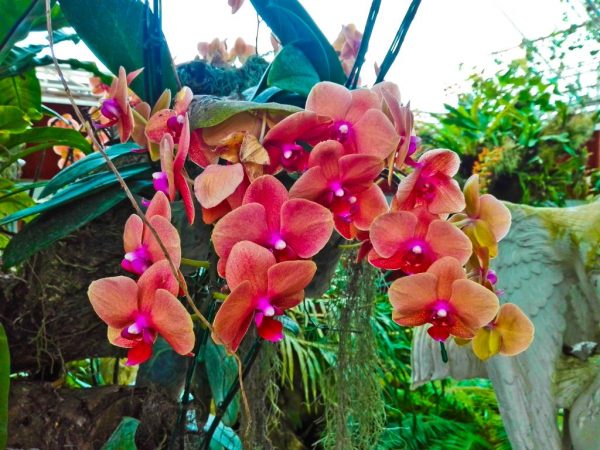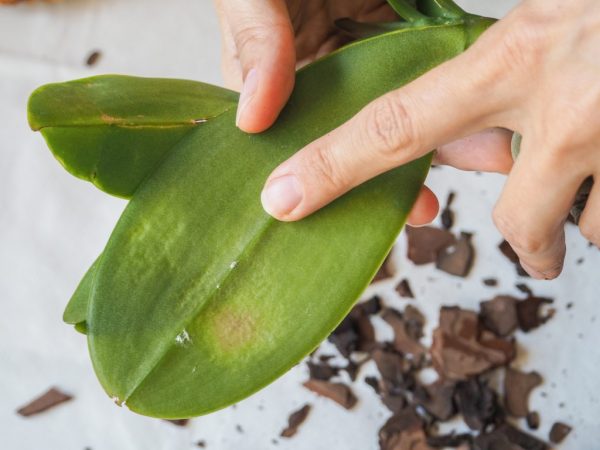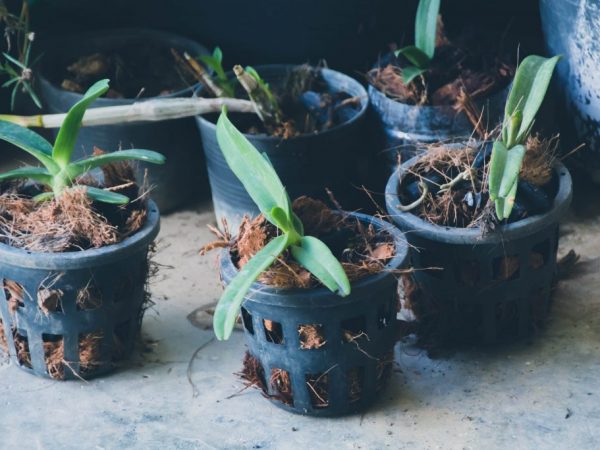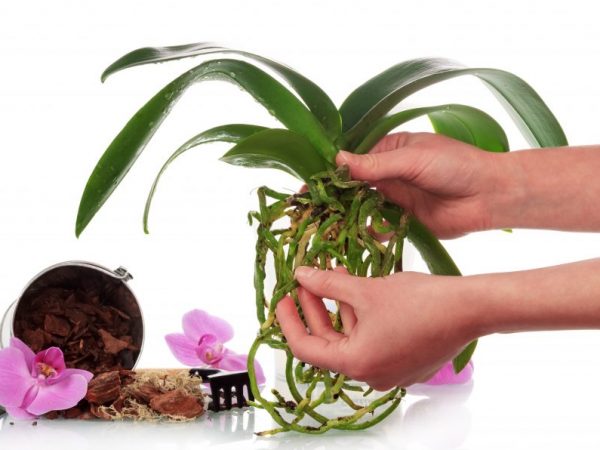What to do with the loss of foliage turgor in an orchid
Orchids are known not only for their beauty, but also for their capricious content. If the leaves of the orchid have lost their turgor and wrinkle, you will have to find the main reason for this phenomenon and reanimate the plant in a timely manner. The lethargy of foliage is a sign of the slow death of the flower.

What to do with the loss of foliage turgor in an orchid
What is foliage turgor
Turgor is the health of the orchid leaf plate, its normal and natural appearance. The leaf plate should be upright, dense, elastic and have a light waxy coating.
Orchids are epiphytic plants. For development, the florist must create the necessary conditions not only for the roots, but also for the green mass of the flower, therefore, the turgor of the leaves of an orchid is an indicator of the health of an exotic pet. And if he disappeared, the plant signals a disease or a lack of care from the owner. Also, the plant reacts poorly to the depletion of minerals by the experienced long flowering.
Causes of sluggish foliage of orchids
To organize proper care for orchids, it is important to understand the features of identifying signs of a pathological state of foliage, as well as the main reasons leading to this. If on the stem of an orchid, consisting of 4-5 pairs of leaves, 1 or 2 turn yellow and wrinkle, do not worry. These traits are often characterized by natural processes associated with the aging of the green mass and its gradual replacement by young foliage.

The orchid loses the turgor of most of its leaves due to weak immunity.
If an orchid has lost the turgor of most of its leaves, the problem is not natural processes. Such signs are observed only when the flower has weak immunity and suffers from factors negatively acting on it. If the turgor of the leaves of the orchid is lost, the reasons may be:
- excessive or insufficient moisture of the substrate that contains the flower;
- overheating of the roots;
- high soil density;
- improper feeding;
- disease.
The sooner unfavorable signs are noticed, the faster it will be possible to restore the turgor of the leaves in the orchid. The main thing is to determine the factors that caused the occurrence of such a phenomenon.
Over and under watering
When an orchid loses leaf turgor, the cause is excess moisture accumulated in the soil. Orchid roots love water, but do not tolerate overflow, therefore such plants are often planted in containers with drainage holes through which excess moisture flows into a special tray. If moisture lingers in the substrate, the roots begin to rot and the plant aches.
Another reason is lack of moisture. The overdried substrate ceases to feed the roots, and the flower slowly dies. Not getting what it wants, the orchid weakens: the leaves wrinkle and wither.
Overheating of the root system
For the correct cultivation of Orchids, it is important not only the condition of the soil, but also the temperature and humidity of the air. In summer, the flowers on the windowsills suffer from direct sunlight. An increase in temperature accelerates the process of evaporation of moisture from the soil, and the scorching rays of the sun have a detrimental effect on the condition of the leaf plates.

When growing an orchid, temperature and humidity are important.
As a result, the roots overheat, the foliage loses its healthy appearance, the flower gets sick and dies. It will be possible to restore the turgor of the grown orchid only if the plant is provided with timely assistance. It is important to organize suitable conditions for keeping the flower, providing it with diffuse light, favorable temperature and humidity.
Fertilizing plant errors
If the orchid has lost the turgor of its leaves, errors in fertilization of the crop may also be the reason. It is important for a pet to provide top dressing that will restore its strength after abundant long flowering, for the growth of the root system and green mass. Also, fertilizers will help to grow children - important young shoots for the development of orchids and their reproduction.
When a pet loses its healthy and natural appearance, they remember when feeding is carried out and what formulations were previously used. The reasons may be:
- Errors in the dosage of mineral formulations and their incorrect use. Concentrated solutions have a poisonous effect on flowers, and even a few drops on the foliage and stem lead to burns and damage to healthy tissues.
- Use of fertilizers with a high potassium content. Such dressings stimulate the orchid to bloom, which negatively affects the condition of the roots and green mass.
- Use for the preparation of solutions with mineral fertilizers tap water. It contains a large amount of salts that negatively affect the condition of the roots.
It turns out to return the turgor of orchid leaves if the florist identifies his mistakes in caring for the plant. By normalizing the feeding, it is possible to save the flower and restore its health and natural appearance.
High substrate density
Orchids feed on both moisture and air. Most of all, the root system needs them. If the soil containing the flower is dense and heavy, the roots will lose airing, which will lead to their decay. As a result, the foliage will begin to wither and dry out.

Dense and heavy soil will rot
The soil in the pot tends to sag and thicken over time, so replanting an orchid every 3-4 years is a necessity. The only exception is specialized granulates, which do not lose their properties for decades. These substrates are not suitable for all orchid species.
Diseases
Most of the diseases that a pet can contract are associated with improper care of it. Rot arises in the roots with excessive watering and low air temperatures, and viral and bacterial infections are brought in with work equipment.
The recovery of a flower depends on the characteristics of the disease and on the timeliness and correctness of the provision of assistance. Infection with viral diseases often leads to the death of orchids.
How to revive a plant
The actions of the grower depend on the causes of the pathological state of the flower. Having identified the signs of negatively influencing factors, they are engaged in saving the plant:
- With poor organization of watering. With a lack of moisture, the turgor of orchid leaves is restored by increasing the frequency of procedures. A sick flower is more actively watered or soaked in water for several hours a day. With an excess of moisture, an inspection of the root system and the removal of its damaged parts, followed by transplantation, is required.
- In case of errors in feeding. The lack of nutrients is compensated by the introduction of a complex composition with a high nitrogen content.Excess fertilizer is solved by rinsing the roots in water and transplanting the flower into a new substrate.
- In case of illness. They act according to the characteristics of the treatment. Can use fungicides and root stimulants.
- With high soil density. The problem is solved by transplanting into a new light and nutritious soil.
They struggle with signs of overheating by moving the container with a flower to another place where the necessary microclimatic conditions (temperature and humidity) will be met. The flower is well watered. Spraying with a weakly concentrated solution has a beneficial effect.
Preventive measures
In order for the culture to grow healthy and delight the owner with abundant and long flowering, they take care of the prevention of lethargy of the foliage. Orchids should be correct:
- water and spray;
- fertilize;
- maintain the temperature regime;
- replant every 3-4 years.
Preventive spraying against diseases and pests is also useful. With properly organized flower maintenance, foliage health problems do not threaten it.
Conclusion
It is possible to revive an orchid with lethargy and wrinkling of its foliage only after determining the reasons leading to such a pathological condition. Most of the treatments are limited to changing the care of the whimsical flower. The need for treatment with specialized drugs is observed only when signs of disease are detected.


